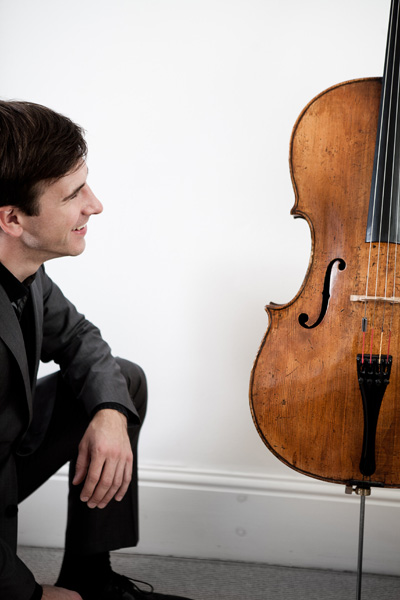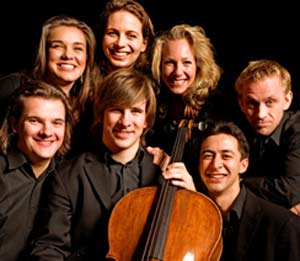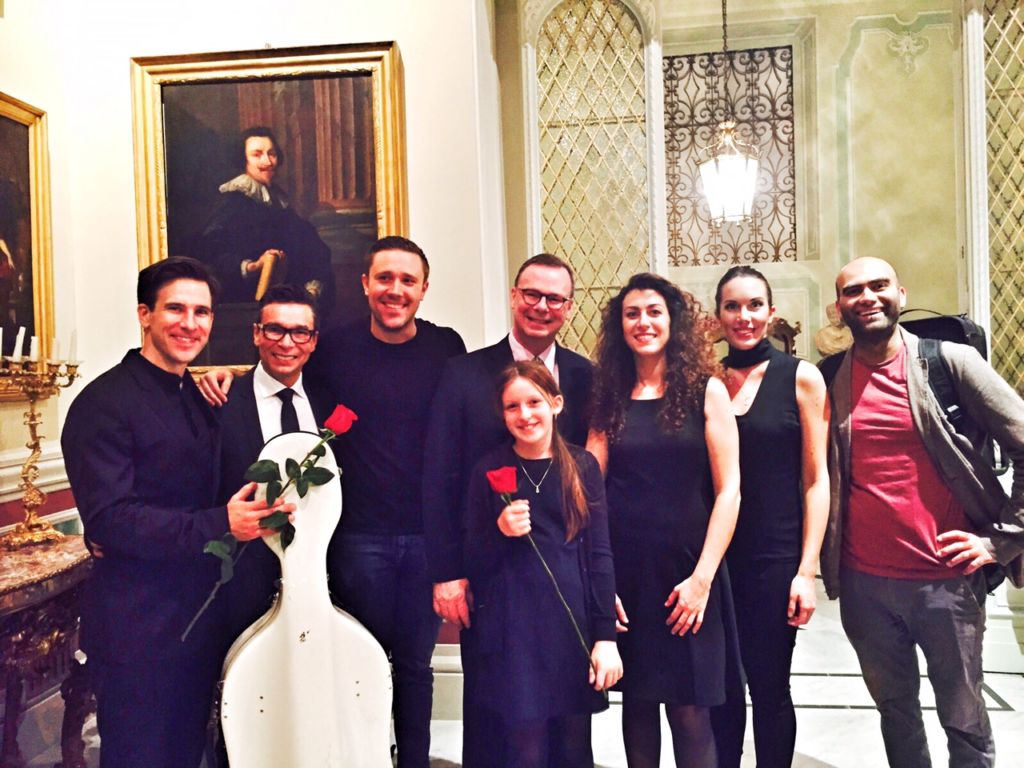What is Tecchler300?
My cello was made in Rome in 1714 by David Tecchler. 300 years on, I decided to mark this special
What is Tecchler300?

My cello was made in Rome in 1714 by David Tecchler. 300 years on, I decided to mark this special anniversary by commissioning 3 new works as gifts for the cello by celebrated British composers David Matthews, Mark Simpson and Charlotte Bray. I asked them to think of the role of the cello in the last 3 centuries and to let their imagination run wild, which they certainly have!
I began to ask myself lots of questions – How did David Tecchler end up settling in Rome, who was he making cellos for, and how did this cello come into my hands? What is my journey and role as a cellist in the 21st century?
I also began to dream of the idea of taking the cello back home all these years later and getting to the root of some of these questions. Thanks to the support of a wonderful team, I’m now looking forward to embarking on this exciting journey and I hope you enjoy the various blogs and musical offerings captured along the way.

Guest post: Serendipity (Miranda Fulleylove)
It was early in April 2015 that I had a brief conversation with my friend (and lodger) Guy Johnston
Guest post: Serendipity (Miranda Fulleylove)

It was early in April 2015 that I had a brief conversation with my friend (and lodger) Guy Johnston about his plans to research the origins – and subsequent history – of his beautiful cello, made in Rome in 1714 by David Tecchler. I was about to go to Rome for a few days, so Guy asked me if I could try to find Tecchler’s workshop while I was there. His friend David Souden had discovered an address in Rome where Tecchler was said to have worked -16 Via die Leutari, in the parish of San Lorenzo in Damaso. Via dei Leutari, of course, means ‘street of luthiers’…
This happened to be only 10 minutes walk from my hotel in Rome, so off I went on the morning of 9th April and found the building easily. It is in a narrow street running at a right angle to the Corso Vittorio Emmanuele and is roughly midway between the Piazza Navona and the Campo dei Fiori. No one seemed to be in when I rang the bell, so I took a few photos of the building and of the large wooden doors at the base of it. Looking behind me, I noticed that the house opposite had been occupied, roughly 100 years after Tecchler’s occupation of number 16, by the composer Gioacchino Rossini, while he wrote the opera, The Barber of Seville.


A man and a woman sitting at a table on the street, just outside a nearby workshop, were looking at me a little suspiciously. I explained to them that I was interested in the building at number 16 and wondered if they knew where the owner was. They said they had no idea, but very helpfully suggested that if I was interested in the area, I should visit the local bookshop, just at the top of the street, which might have a book about the local buildings…
I wandered into the bookshop with my husband Peter who had just arrived to join me on the search. But within seconds, the man I’d seen sitting in the street returned with another man in tow, whom he introduced as Stefano Sbordoni, the owner of the building at number 16, Via dei Leutari! It turned out that Stefano, who spends most of his time in Tuscany, just happened to be in Rome that day, getting his motor cycle repaired….Somehow, this story was meant to grow.
I explained to Stefano that we were looking for the workshop of a famous luthier, on behalf of a friend. Stefano was instantly interested, instantly helpful and instantly friendly. He suggested we sit down at a cafe over the road where we talked for half an hour and found out that he was not only a music-lover, an amateur flautist and a producer of wine in Tuscany, but that he was deeply interested in the history of his building ( or ‘palazzo’ )’ which is now converted into self-catering apartments , and that he would try to track down a book he knew which documented the buildings of that parish of Rome and the uses to which they had been put from the 16th century until today. The book is called ‘Le Botteghe d’Arte…di una zona di Roma dalla fine del XVI secolo a oggi’ – by Saverio Franchi and Orietta Sartori. (Artisans’ Workshops in an Area of Rome from the end of the 16th century until Today.)
In the meantime, Stefano took us to his ‘palazzo’ and opened up those huge wooden doors at the bottom, revealing Mr Tecchler’s workshop, which currently housed Stefano’s motorbike, a few bicycles and a lot of other household stuff, but whose wooden ceiling and stonework appeared to be a few centuries old. The building itself had been much renovated during the 18th and 19th centuries, and the floors above the ground floor are now converted into self-catering apartments, but Tecchler’s actual workshop (or currently, ‘garage’, as Stefano apologetically described it!) appears not to have been much altered.


Just 4 hours later, the extraordinary Stefano personally delivered a copy of the book to my hotel. It shows that during the 17th and 18th centuries the entire area around Via dei Leutari was full of artisans’ workshops. Other artisans of that period included tailors, shoemakers, carpenters, bookbinders, printers, mapmakers, as well as countless makers of stringed instruments. (Many musical performances of that time would have been given at the nearby Teatro Della Pace as well as in local churches and it was the presence of the many musical ensembles in the area, (including string players) which drew many instrument makers to work in Rome. Tecchler himself, alongside several other luthiers of the 17th and 18th centuries, came from Austria to work there).
The book also documents that David Tecchler had used the workshop on the ground floor of 16 Via dei Leutari from around 1688 until 1703. After getting married he moved to an adjoining parish in 1699 but continued to lease the workshop at 16 Via dei Leutari until 1703. We don’t yet know where his next workshop was situated, except that it was somewhere in a neighboring parish. So the research will continue; Guy’s cello was finished in 1714; whether we will ever know exactly when it was begun, and whether Tecchler already had the wood, (which he would eventually use to make that particular cello), while he was living at Via dei Leutari, are questions which may never be answered.
But the ever helpful and enthusiastic Stefano quickly agreed that a solo performance by Guy, on his Tecchler cello, should take place in that very ‘garage’ where Tecchler once worked, (as well as a performance of one of Rossini’s lovely string sonatas, in honour of that composer’s presence, a century later, in the building opposite). I never dreamed that we would get so far in just one day! With great goodwill and excitement Stefano is now clearing his ‘garage’ and transforming it into a space where Tecchler’s work of art, with Guy’s help, will soon fill it with wonderful sound.
Plans are going ahead for 16th October 2016… Watch this space.
Miranda Fulleylove
All Roads Lead to Rome… Video 1
Check out our first video about the Tecchler300 project:
All Roads Lead to Rome… Video 1
Check out our first video about the Tecchler300 project:
Guest Post: Recording Beethoven at Hatfield House (Tom Poster)
Guy, Magnus and I have been playing piano trios together since 2001, though we’ve had some pretty big gaps in
Guest Post: Recording Beethoven at Hatfield House (Tom Poster)
Guy, Magnus and I have been playing piano trios together since 2001, though we’ve had some pretty big gaps in the middle. Following memorable experiences in our early 20s as the King’s Piano Trio, featuring Irish castles, a plethora of goblins and all sorts else, we tended to gravitate towards larger chamber repertoire as we expanded outwards into the Aronowitz Ensemble from 2004 onwards. But a series of opportunities has brought us back to our trio formation over the past season, and the rediscovery has been a source of great joy. There’s an intensity to the trio combination, which often requires a more soloistic approach from all three players than the quartets and quintets we’ve spent so much time playing, and in which everything feels a little more exposed; but the repertoire is so rich, and the challenges so rewarding, that we’ve been left with a renewed determination to explore a medium we feel we’ve neglected a little in recent years.






Guest Post: Serenity ( Seb Johns )
The first experience of singing with Guy Johnston was in the final ‘dress rehearsal’ before the filming of Carols from King’s,
Guest Post: Serenity ( Seb Johns )
The first experience of singing with Guy Johnston was in the final ‘dress rehearsal’ before the filming of Carols from King’s, when he joined the choir to perform the cello part of Ola Gjeilo’s Serenity. As soon as he arrived, with a notable lack of music, it was clear that, having committed the part to memory in a matter of days, this was to be a rather professional venture. As soon as we started the first run, Guy’s playing was immaculate, and it was no surprise when this carol went on to be one of the stand out and most popular of the entire Christmas service .
The second time we performed it was in June (almost exactly half a year away from Christmas…!) when Guy returned to King’s to record the piece with us for his upcoming CD. Despite the piece being really rather tricky to sing due to the extremely long and sustained nature of the writing, it was once again wonderful to be able to hear the cello part played quite so beautifully, and listening back afterwards the result was quite something. Not only was Guy wonderful to chat to throughout the session (perhaps he knows the potential dullness of recording sessions from his time as a treble in the very same choir), but he also joined us choral scholars for a drink after the session – being able to chat to the soloist(s) like this isn’t something we often get to do! Guy was even polite enough to humour my conversation when I accidentally ruined a camera shot of him strolling alongside the chapel by asking him about his cello…


A Roman Adventure…
So we finally made it to the first of our two experiences in Rome. It took just over a year
A Roman Adventure…
So we finally made it to the first of our two experiences in Rome. It took just over a year to plan and somehow we made it a reality. 20 supporters joined us on a journey to Rome to help launch our fundraising efforts to record with the Accademia di Santa Cecilia in celebration of my cello which was made there 300 years ago.
We had welcome drinks followed by an array of unique experiences throughout the weekend: a tour to the Tomb of St. Peter, lunches and dinners, concerts at the iconic Pamphilj Palace and Oratorio Del Gonfalone and a gathering in Tecchler’s neglected workshop in what is now a garage!

You may have read Miranda’s earlier Blog about her chance meeting with the owner of the garage last year. Stefano generously opened the door for us, proud to learn the fact that his garage was once used as a workshop by an eminent Luthier, and we fittingly performed some Rossini in memory of the composer who had once lived opposite there on Via dei Leutari. I stayed in an apartment above the garage musing and wondering when my cello might last have been in Rome.

Being in Rome in the flesh at last, performing and lapping up the spirit of this extraordinary ancient city, beyond just seeing ideas written down on paper, was a delight from beginning to end. I took myself off for early morning runs absorbing as much as I could of the city while we were there. We were walking back to our hotels after the Pamphilj concert and amused ourselves at every turn with yet another historic landmark which took our breath away. Turning off one street towards the Trevi Fountain one moment, the Pantheon the next and on it went like that.

It was a memorable weekend sharing music with friends and meeting new ones too. We had a ball of a time made even more special with wonderful musicians from the orchestra, Roberto and Anita, as well as Gloria, Buhrang, Luigi and friends from the UK, Miranda and Louise. It really was a dream come true and I’m already looking forward to the next trip in the New Year. It would not have been possible without the immense efforts and support behind the scenes. Thank you to all involved and here’s to the rest of the journey ahead!

Guy
Tarisio Article about Rome 26/4/17
Pre-Order a CD!
It’s exciting to have this journey captured on recording. Here’s a short video about the first track. You can now Pre-Order a
Pre-Order a CD!
It’s exciting to have this journey captured on recording. Here’s a short video about the first track. You can now Pre-Order a CD here including Ola Gjeilo’s Serenity for free!
Strad Magazine Feature May 2017
Guy on cover of Strings Magazine September Issue
Read an article about Guy’s journey from Cambridge to Rome in September’s issue of the Strings Magazine. You can order
Guy on cover of Strings Magazine September Issue
Read an article about Guy’s journey from Cambridge to Rome in September’s issue of the Strings Magazine. You can order a copy here or go to their app and download the article.

“On the Trail of Tecchler” BBC Music Magazine September Issue
You can read an article by Helen Wallace about Guy’s journey from Cambridge to Rome in September’s edition of the
“On the Trail of Tecchler” BBC Music Magazine September Issue
You can read an article by Helen Wallace about Guy’s journey from Cambridge to Rome in September’s edition of the BBC Music Magazine. Look out for a copy here
